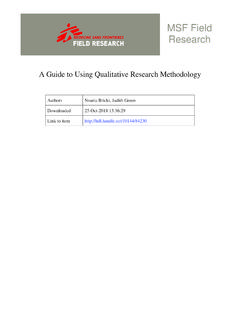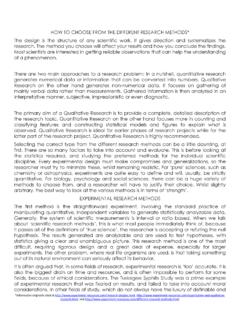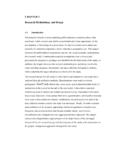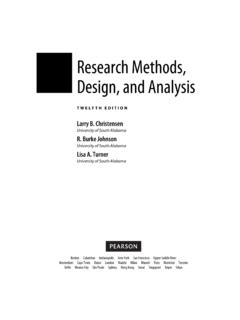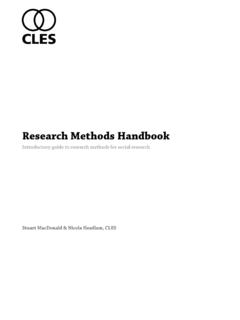Transcription of A Guide to Using Qualitative Research Methodology
1 A Guide to Using Qualitative Research Methodology MSF FieldResearchAuthorsNouria Bricki, Judith GreenDownloaded17-Apr-2018 22:28:19 Link to Guide to UsingQualitative Research Methodology 2002 Michael Quinn Patton and Michael CochranReproduced with kind permission of Michael Quinn PattonExecutive SummaryThis Guide to Using Qualitative Research Methodology is designed to help you think about all the steps you need to take to ensure that you produce a good quality piece of work. The Guide starts by telling you whatqualitative Methodology is and when to use it in the field (understand people s belief system, perspectives, experiences). It also flags the most important ethicalissues that you will encounter (consent and confidentiality). The second part of the Guide tackles how you can concretely develop Qualitative Research designs; starting from clearly defining your Research question (one of the most important steps in your Research !)
2 , to how to develop a Research protocol; and finally giving you tips on the sampling methods which are available and how to use third part details how you can actually obtain the data - what methods can you use to get the information you want? The three main methods (individual interviews, group interviews and observationalmethods) are explained, and the steps to build these different methods are outlined (How to do a topic Guide ? How to ask questions? How to develop interview skills and manage expectations? How to run group discussions? etc)Finally, the fourth chapter looks into how, once you have collected all the data, you can manage it and analyse it. For themanagement of data, a few practical issues are addressed, such as confidentiality and security, translation and recording. The analysis section will give you clues as to how to use thematic or narrative analysis, what validation strategies you need to think of, what good practice guidelines you should follow, and whether or not to use a computer studies will be developed throughout the year and put on the open Guide to Using Qualitative Research MethodologyContents1.
3 What is Qualitative Research ? Aims, uses and ethical issues a) What is Qualitative Research ? 2 b) When to use Qualitative methods 3 c) Ethical issues 52. How to develop Qualitative Research designs a) The Research question 7 b) The Research protocol 8 c) A word on sampling 93. How to generate data (i) Individual interviews a) Interviews- what are they? 11 b) Topic guides 12 c) Asking questions 13 d) Interviewing skills 14 e) Managing expectations 15 (ii) Group interviews a) What is a group interview? 16 b) Advantages of group interviews 16 c) Practical issues 17 (iii) Contextual data a) Observations 20 b) Reports and other written data 21 c) Oral data 214. Data management and analysis (i) Practical issues Confidentiality and security issues 22 Translation 22 Recording/transcribing interviews 22 (ii) Analysis Thematic analysis of data 23 Narrative analysis 25 The use of computer software 28 1.
4 What is Qualitative Research ? Aims, uses and ethical issues(a) What is Qualitative Research ? Qualitative Research is characterised by its aims, which relate to understanding some aspect of social life, and its methods which (in general) generate words, rather than numbers, as data for analysis. For researchers more familiar with quan-titative methods, which aim to measure something (such as the percentage of people with a particular disease in acommunity, or the number of households owning a bed net), the aims and methods of Qualitative Research can seem imprecise. Common criticisms include: samples are small and not necessarily representative of the broader population, so it is difficult to know how far we can generalise the results; the findings lack rigour; it is difficult to tell how far the findings are biased by the researcher s own opinions.
5 However, for many Research projects, there are different sorts of questions that need answering, some requiring quantitative methods, and some requiring Qualitative methods. If the question is a Qualitative one, then the most appropriate andrigorous way of answering it is to use Qualitative methods. For instance, if you want to lobby for better access to health care in an area where user fees have been introduced, you might first undertake a cross-sectional survey which will tell you that of your population does not have access to care. This is essentialinformation, but you might also have a number of other questions that the survey can t answer very well, such as: what are people s experiences of user fees? what other barriers exist to accessing health care?These can be addressed throughqualitative methods such as interviews or focus groups.
6 If the final report is to be used for lobbying, the quantitative data and Qualitative data together are very powerful. The survey identifies the extent of the problem, and the interviews can be used to give some of the detail, and the story of how user fees have affected situations where little is known, it is often better to start with qualitativemethods (interviews, focus groups, etc). It can help you with generating hypotheses that can then be tested by quantitative methods. For instance, in an area where we had no idea what kinds of issue were acting as barriers to health care, it would be difficult to design a survey to cover the main factors. Once these have beenidentified, then a quantitative approach (such as a survey) can be used if you need Not everything that can be counted counts, and not everything that counts can be counted (Albert Einstein)23to measure to what extent these issues are typical for the whole first step in Research is, then, toidentify whether the specific researchquestion you want to answer is bestanswered by a quantitative or a Qualitative approach.
7 Often, there are severalquestions that we need to answer, such as How many people are affected? , or How does this affect them? . We d then need to use both types of this Guide , we suggest some ways of making the Qualitative parts of your Research more rigorous, so that users can have more faith in your findings. The first step, though, is to clarify some of thesituations in which Qualitative methods might be Study: What are the barriers to accessing surgery for cataracts?1 Although affordable surgery for cataracts is provided by an Eye Care Programme in a rural part of KwaZulu-Natal, researchers foundthat uptake was low, and that two-thirds of those who were blind or sight impaired from cataracts had not had surgery. Alan Rotchford and colleagues wanted to understand why elderly people in this area might not take up surgery.
8 They interviewed 20 people who had been invited for surgery, but did not attend, asking them about the impact of poor vision on their lives, their beliefs about blindness and its treatment, and views of surgery. The interviews revealed a number of fears about surgery: that it would make vision worse, or might kill them. Many thought blind-ness was an inevitable risk of getting older. Most significantly, however, the interviewees did not share the researchers perspectives of blindness as a disability. Living in secure and predictable environments with extended families, they did not in general see their blindness as a burden . The impact of sight disability was not as debilitating as it might be in other environments. This study illustrates the value of Qualitative methods. It identified some beliefs about surgery that were different from those ofprofessionals, and also some more fundamental reasons why surgery might not be a priority: poor eyesight was not as devastating a disability as assumed by the researchers.
9 (b) When to use Qualitative methods?What, how, and why? Qualitative methods generally aim tounderstand the experiences and attitudes of patients, the community or health care worker. These methods aim to answer questions about the what , how or why of a phenomenon rather than how many or how much , which areanswered by quantitative methods. If the 1 Rotchford, , Rotchford, , Mthethwa, and Johnson, (2002) Reasons for poor cataract surgery uptake a Qualitative study in rural South Africa , Tropical Medicine and International Health, 7(3): 288-29223aim is to understand how a community or individuals within it perceive a particular issue, then Qualitative methods are often of topics that qualitativemethodologies can address include: People s experiences of health needs, health care, accessing care and keeping healthy.
10 Understanding different perspectives, such as those of professionals and patients. How experiences, attitudes and life circumstances affect health needs and where qualitativeresearch could help An NGO has distributed bed nets to villagers, but it appears that they are not being used. Household interviews might help the NGO understand how beliefs about efficacy, family circumstances or household priorities impact on usage patterns. You are planning a health promotion campaign about hand washing, to reduce diarrhoeal disease in a refugee camp. Before designing the campaign, it would be useful to interview residents to find out their current beliefs and practices around hand washing, so your information makes sense within their understanding.
